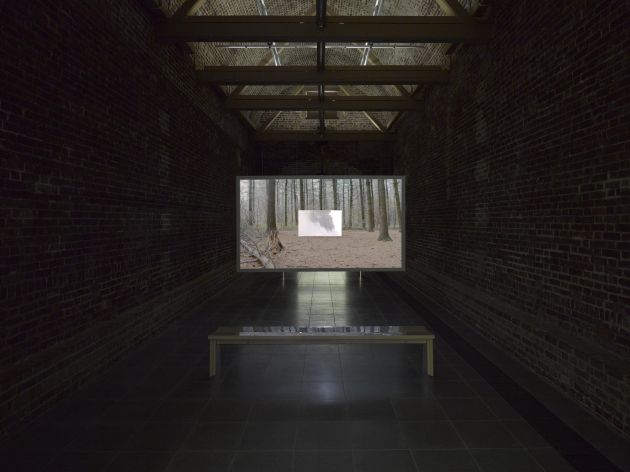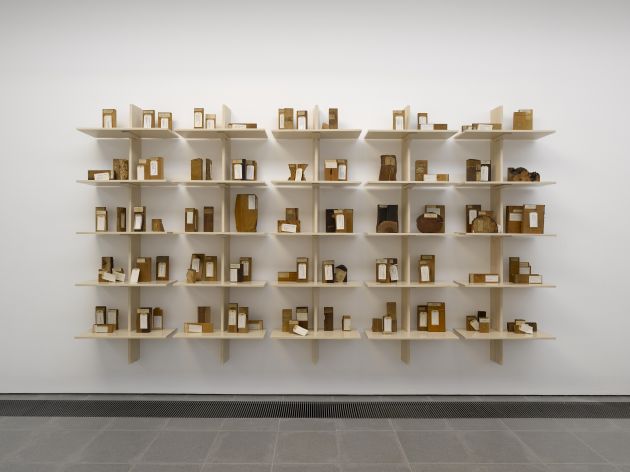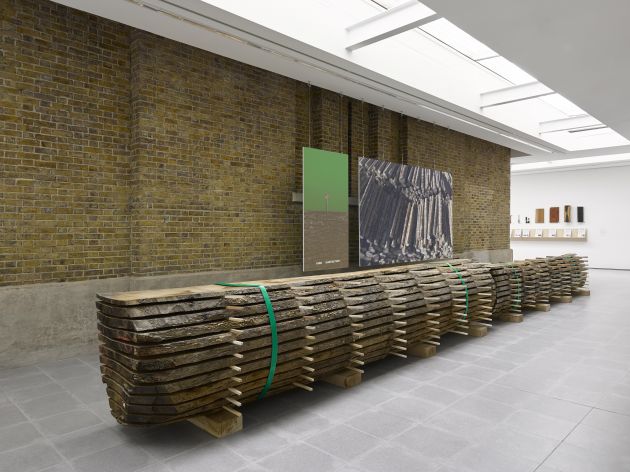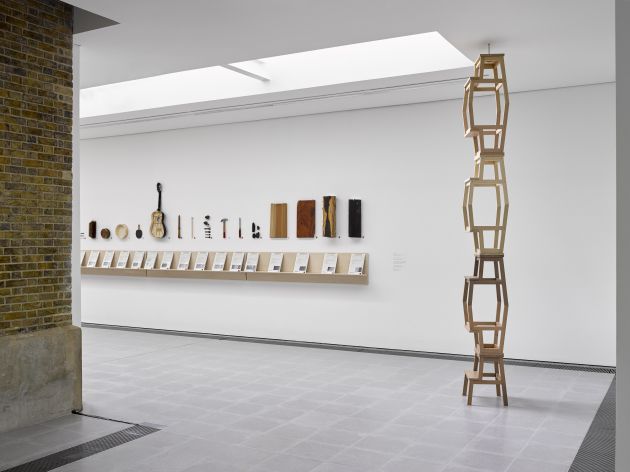 The Serpentine Sackler has been filled with wood, and infused with specially-designed scents. Photo: George Darrell.
The Serpentine Sackler has been filled with wood, and infused with specially-designed scents. Photo: George Darrell.
The Amsterdam-based design duo’s exhibition at the Serpentine serves as a rebuke to global industry and a call for a systematic approach to the environment, finds Joe Lloyd.
The first thing that strikes you when you enter Cambio, Formafantasma’s new exhibition at London’s Serpentine Sacker Gallery, is not necessarily the dominance of wood as a medium but rather the scent. One of two fragrances designed by the Norwegian smell researcher Sissel Tolaas for the show, it conjures up the aroma of woodland untouched by human hands.
It does not take long, however, for humanity’s role in shaping the natural world to become evident. The gallery’s entrance hall contains an oak trunk from an Essex sawmill, laid vertically and sliced into segments. At the top, we see the knotted, organic form of tree bark; look down to the central slice, though, and the tree has been carved into smooth, unnaturally regular planks, fit for wooden production. The message is clear: we have taken nature’s bounty and shaped it to fit our needs, distorting it in the process.
 Cambio contains numerous video works. Photo: George Darrell.
Cambio contains numerous video works. Photo: George Darrell.
Cambio is only the third design show in the Serpentine’s 50-year history as a contemporary art kunsthalle. It aims to inaugurate a series of shows on design’s radical edges. ‘Art can learn from design,’ writes curator Rebecca Lewin in the exhibition’s catalogue, ‘and its prerequisite to adhere to technical functionality — not because art cannot be functional, but rather that design is always embedded in the world at large.’
Formafantasma’s two members, Andrea Trimarchi and Simone Farresin, have always been concerned with design’s relationship to wider communities. The pair met while studying in Florence, then applied to Design Academy Eindhoven where they were the first pair to graduate as a team. From the off, they were adept at bribing the apparent gulf between the sort of object-making that characteristics traditional conceptions of design and the conceptually-led, socially-engaged tendency that has revitalised the medium this past century.
 There are numerous samples from the Kew Economic Botany Collection, which collected trees from across the British Empire to work out their usefulness to industry. Photo: George Darrell.
There are numerous samples from the Kew Economic Botany Collection, which collected trees from across the British Empire to work out their usefulness to industry. Photo: George Darrell.
Even when the physical outcome of their work takes the form of a conventional furniture piece — such as last year’s ExCincere collection of tiles glazed using ash from Mt. Etna — Formafantasma’s products are genuinely research driven. That research has tended to focus on what is possibly the most important design issue of our time, the impact of human production on the Earth’s fragile environment. Their project Ore Streams (2017-19), commissioned by NGV Australia and Triennale Milano, saw them investigate discarded electronic goods and transform it into furniture.
While today’s designers have initiated countless projects that aim to reduce waste, increase sustainability and protect the world’s resources from rapacious business, Formafantasma have called out the myopic, short-sighted nature of many of these schemes. ‘We believe,’ they write, ’that the designer can be a critical agent in global systems, but their skillset and perspective must expand rapidly beyond isolated, self-referential processes of artistic making and subjective intuition.’ Only by changing the systems that cause the ravaging of the environment can we hope to save it.
 The exhibition opens with a sliced oak tree that shows how manufacturing alters nature. Photo: George Darrell.
The exhibition opens with a sliced oak tree that shows how manufacturing alters nature. Photo: George Darrell.
Cambio — named for the Medieval Latin word for ‘change’ or ‘exchange’ — is a full-bore manifestation of this holistic approach. The exhibition design, naturally created by the studio, all derives from a single tree felled in a calamitous 2018 storm in the Val di Fiemme in Alpine Italy, which saw 1 million square km of spruce forest torn asunder by violent winds. A video shows distressing footage of this catastrophe, while two nearby sound pieces demonstrate the extraordinary resonance of these trees, famously used in the production of Stradivarius violins.
These multimedia works are characteristic of Cambio, which fuses video, sound, scent, textual and pictorial works with archive-like arrangements of wood samples and objects. One film work, edited using chroma key compositing to install a college-like effect, condenses the complete history of plants on Earth, from primordial flora to contemporary forestry techniques, into 23 minutes and 21 seconds. Another displays LIDAR technology, often used by loggers to asses which trees to fell, while the environmental philosopher Emanuele Coccia reads out a monologue from the perspective of a tree. ‘We fabricated the terms of your existence,’ he utters.
 Cambio seldom resembles a traditional design exhibition. Photo: George Darrell.
Cambio seldom resembles a traditional design exhibition. Photo: George Darrell.
With the exception of a stack of chairs based on an Ikea model, each made of a wood with a different CO2 footprint, there is little here resembling the shelves and storage solutions of the Serpentine’s last design show by Martino Gamper in 2014. Instead, Formafantasma have convened an extensive investigation of how we use wood, in collaboration with a fully credited array of scientists and thinkers. One wall is given over to a series of objects – violins, hammers, books, brushes, drumsticks and more — that were taken for assessment at wood research institutes in Belgium and Germany. Each was scientifically examined to uncover its provenance and likely legality: an astounding 16 to 19 per cent of timber imports to the EU derive from illegal logging.
A nearby display of 18 editions of Charles Darwin’s Origin of Species features similar analysis and unveils worrisome evidence of the scale of international manipulation of trees. A Brazilian copy, for instance, is made of paper sourced from Norway, from a tree native to Australia and Malaysia. Often in this exhibition, the punch comes not from the (beautifully arranged, of course) objects themselves but from the small-print text report next to them, something which a heavier-handed touch might have made the exhibition a little dry. To Trimarchi and Farresin’s credit, the decision to pile their exhibition up with written reports allows the visitor to re-enact a form of their own process of discovery, stimulating active engagement with their topic.
 One section juxtaposes a map designed to encourage exploitation of the Amazon rainforest with those drawn by indigenous groups. Photo: George Darrell.
One section juxtaposes a map designed to encourage exploitation of the Amazon rainforest with those drawn by indigenous groups. Photo: George Darrell.
Elegantly presented, rich in detail and broad but concentrated in view, the exhibition is an adept demonstration of design’s usefulness in spaces and formats more usually given over to art. It is also a starting post: Formafantasma’s research into the subject will inform the Geo-Design course that they will begin to teach in Eindhoven this September. Cambio is also quite brave. It unleashes a rebuke to two centuries of design practice, while remprimanding those designers and manufacturers whose environmental ambitions fail to take into account the systems that they perpetuate. If designers are to have any role in sparing our world from climate catastrophe, Formafantasma must be heeded.
Formafantasma: Cambio is at the Serpentine Sackler Gallery, London until 17 May 2020


















